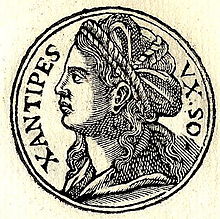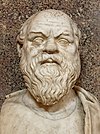
Xanthippe (/zænˈθɪpi/; Ancient Greek: Ξανθίππη [ksantʰíppɛː]; fl. 5th–4th century BCE) was an ancient Athenian, the wife of Socrates and mother of their three sons: Lamprocles, Sophroniscus, and Menexenus. She was likely much younger than Socrates, perhaps by as much as 40 years. In Xenophon's Symposium, she is described by Antisthenes as "the most difficult, harshest, painful, ill-tempered" wife; this characterisation of Xanthippe has influenced all subsequent portrayals of her.
Life
Little is known about the life of Xanthippe. The ancient sources that mention her do so primarily to illustrate something about the character of Socrates, rather than provide any biographical information about Xanthippe. She was probably born around 440 BCE, making her around 30 years younger than Socrates, who was born c. 470. Xanthippe's father may have been called Lamprocles, and Socrates and Xanthippe's eldest son been named after him; this may have been the Lamprocles mentioned by Aristophanes in the Clouds, who was a well-known musician in fifth-century Athens.
Xanthippe and Socrates apparently married after 423 BCE, as in Aristophanes' Clouds Socrates seems to be unmarried. She bore Lamprocles around 415 or 414 BCE. She may have been the mother of Socrates' other two children, Sophroniscus and Menexenus. Athenaeus and Diogenes Laertius both report versions of a story that Socrates married twice, once to Xanthippe and once to Myrto, the daughter or granddaughter of Aristides the Just. This story has generally not been believed by modern scholars, though some have accepted it – for instance J. W. Fitton, who argues that Myrto was Socrates' wife whereas Xanthippe was a citizen pallake ("concubine").
On the basis of her name (a compound of hippos, "horse", which often indicated a noble background) and the fact that her eldest son was, contrary to the usual Athenian practice, not named after Socrates' father, some scholars have suggested that she was from an aristocratic family. Fitton however notes that non-aristocratic Athenians with "hippos" names are known, and argues that though Xanthippe was an Athenian citizen she was not from an especially aristocratic family.
Character

Xanthippe is mentioned only once by Plato, in the Phaedo, depicted sitting by Socrates on the night before his execution. There is no evidence in Plato's portrayal of the shrewish Xanthippe of later tradition. The characterisation of Xanthippe as a difficult wife derives from Xenophon's depiction of her: in the Memorabilia, though she is not named her son Lamprocles complains of her harshness, and in Xenophon's Symposium, Antisthenes describes her as "the most difficult, harshest, painful, ill-tempered" wife. Socrates says that he chose her precisely because of her argumentative spirit:
It is the example of the rider who wishes to become an expert horseman: "None of your soft-mouthed, docile animals for me," he says; "the horse for me to own must show some spirit" in the belief, no doubt, if he can manage such an animal, it will be easy enough to deal with every other horse besides. And that is just my case. I wish to deal with human beings, to associate with man in general; hence my choice of wife. I know full well, that if I can tolerate her spirit, I can with ease attach myself to every human being else.
Later ancient authors, such as Diogenes Laertius, largely follow Xenophon's characterisation of her as a difficult wife. Several of the anecdotes reported by Diogenes serve to show Socrates' wit, and to contrast his temperament with that of his wife. In one story told by several ancient sources, Xanthippe pours a jug of water over Socrates' head; according to Diogenes he responded with the quip "Did I not say that thundering Xanthippe also makes water?"

Legacy
Medieval authors who mention Xanthippe largely repeat the ancient anecdotes about her, and follow the example of Xenophon and Diogenes Laertius in portraying her as a difficult wife. In the Wife of Bath's Tale, for example, Geoffrey Chaucer retells Diogenes' story of Xanthippe pouring a water-jug over Socrates' head, though in his version the jug is filled with urine. The first positive portrayal of Xanthippe comes from the 1405 Book of the City of Ladies by Christine de Pizan: her version of Xanthippe attempts to save Socrates from death by taking the poison from him.
This portrayal of Xanthippe continued into the early-modern period. William Shakespeare, for instance, cites her as a proverbially bad wife in The Taming of the Shrew. During the Enlightenment, some followed in the tradition of a shrewish Xanthippe – such as Pieter Langendijk in his Xantippe, of het booze wyf des filozoofs Sokrates beteugeld. Others, however, began to treat her more sympathetically: the German scholar Christoph August Heumann was the first to question the historicity of the negative ancient anecdotes about her.
Addison discusses matrimony in The Spectator no. 482, dated Friday 12 September 1712:
An honest Tradesman, who dates his Letter from Cheapside, sends me Thanks in the name of a Club, who, he tells me, meet as often as their Wives will give them leave, and stay together till they are sent for home. He informs me, that my Paper has administered great Consolation to their whole Club, and desires me to give some further Account of Socrates, and to acquaint them in whose Reign he lived, whether he was a Citizen or a Courtier, whether he buried Xantippe
The novelist Henry Fielding describes the shrewish Mrs. Partridge thus:
She was, besides, a profest follower of that noble sect founded by Xantippe of old; by means of which she became more formidable in the school than her husband; for, to confess the truth, he was never master there, or anywhere else, in her presence.
... for she continued longer in a state of affability, after this fit of jealousy was ended, than her husband had ever known before: and, had it not been for some little exercises, which all the followers of Xantippe are obliged to perform daily, Mr Partridge would have enjoyed a perfect serenity of several months.
—The History of Tom Jones, a Foundling, Book II, Chapters iii & iv.
The English Victorian poet Amy Levy wrote a dramatic monologue called "Xantippe".
In his poem "An Acrostic", Edgar Allan Poe makes references to her although he (allegedly purposely) misspells her name and instead writes 'Zantippe'.
Frank Osbaldistone, the first-person narrator of Rob Roy by Sir Walter Scott (1817), records this event: "While I trembled lest the thunders of their wrath might dissolve in showers like that of Xantippe, Mrs Flyter herself awoke, and began, in a tone of objurgation not unbecoming the philosophical spouse of Socrates, to scold one or two loiterers in her kitchen." (Book 2, Chapter 7)
In Doctor Thorne by Anthony Trollope, the author says of wives 'There may possibly have been a Xantippe here and there, but Imogenes are to be found under every bush.'
Salomon Maimon refers to a woman's "Xanthippe-like character" in Chapter 10 of his autobiography. ("A widow, celebrated for her superior talents, as well as for her Xanthippe-like character, kept a public house at the extremity of one of the suburbs. She had a daughter who yielded to her in none of the above-mentioned qualities, and who was indispensable to her in the management of the house. "
In episode 9 of James Joyce's Ulysses ("Scylla and Charybdis") John Eglinton asks Stephen Dedalus, ″What useful discovery did Socrates learn from Xanthippe?″
In his essay "The Case for Xanthippe" (1960), Robert Graves suggested that the stereotype of Xanthippe as a misguided shrew is emblematic of an ancient struggle between masculinity (rationality, philosophy) and femininity (intuition, poetry), and that the rise of philosophy in Socrates' time has led to rationality and scientific pursuit coming to exercise an unreasonable dominance over human life and culture.
In Academic Graffiti (1971), the poet W.H. Auden memorialized Xanthippe in a clerihew:
Whenever Xantippe
Wasn't feeling too chippy,
She would bawl at Socrates:
'Why aren't you Hippocrates?'
In popular culture
- Xanthippe has a fairly important role in Maxwell Anderson's 1951 play Barefoot in Athens. In the 1966 Hallmark Hall of Fame television production, she was played by Geraldine Page opposite Peter Ustinov as Socrates.
- A fictional account of Xanthippe's relationship with her husband is presented in the play Xanthippe by the British author and playwright Deborah Freeman. Xanthippe was first produced at the Brockley Jack Theatre, London, in 1999.
- Xanthippe plays a minor role in the 2018 videogame Assassin's Creed: Odyssey, in which Socrates states that her argumentative nature is what attracted him to her, rather than her looks.
Honours
Asteroid 156 Xanthippe is named in her honour.
In 1995, P. Naskrecki and R.K. Colwell gave the patronym Xanthippe to a genus of flower mite that inhabits flowers of palms of the genus Socratea and is probably phoretic on the beetles that pollinate the palm.
A species of African white-toothed shrew was described by Wilfred Hudson Osgood in 1910 as Crocidura xantippe, common name "Xanthippe's shrew."
See also
References
- She must have been young enough to give birth to their three children Plato describes in his writings: In the Apology 34d, the sons are described as quite young: two of them "children", the other a "lad"; in Plato's Phaedo 60a, one of them is small enough to be held in his mother's arms. Both dialogues take place when Socrates is supposed to have been 70 years old.
- Saxonhouse 2018, p. 613.
- Saxonhouse 2018, p. 611.
- Saxonhouse 2018, p. 612.
- Nails 2002, p. 299.
- ^ Strobl 2015.
- Nails 2002, p. 183.
- Woodbury 1973, p. 12.
- Bicknell 1974, p. 1.
- Fitton 1970, p. 66.
- e.g. Woodbury 1973, pp. 12–13 believes that Xanthippe was the mother of Sophroniscus and Menexenus; Fitton 1970, p. 57 accepts Diogenes Laertius's claim that their mother was Myrto.
- Nails 2002, p. 209.
- Fitton 1970.
- Fitton 1970, p. 64.
- Brickhouse & Smith 1990, p. 15.
- Fitton 1970, pp. 60–64.
- Saxonhouse 2018, p. 610.
- Saxonhouse 2018, pp. 616–617.
- Saxonhouse 2018, p. 617.
- Saxonhouse 2018, pp. 613–615.
- Xenophon, Symposium 17–19
- Saxonhouse 2018, pp. 615–616.
- Saxonhouse 2018, p. 616.
- "Xantippe, and Other Verse". indiana.edu.
- Ulysses, James Joyce, p. 170. Wordsworth Classics edition. Notes for James Joyce's Ulysses, Don Gifford with Robert J Seidman, Revised and Expanded edition, University of California Press, 1988.
- Auden, W.H. (1971). Academic Graffiti. New York: Random House. p. 60.
- Naskrecki, P. and R.K. Colwell. 1995. A new genus and two new species of Melicharini from Venezuela (Acari: Mesostigmata: Ascidae). Annals of the Entomological Society of America 88:284–293.
Works cited
- Bicknell, Peter (1974). "Socrates' Mistress Xanthippe". Apeiron. 8.
- Brickhouse, Thomas C.; Smith, Nicholas D. (1990). Socrates on Trial. Clarendon Press.
- Fitton, J. W. (1970). ""That was no lady, that was..."". Classical Quarterly. 20 (1). JSTOR 637508.
- Nails, Debra (2002). The People of Plato: A Prosopography of Plato and Other Socratics. Hackett. ISBN 978-0-87220-564-2.
- Saxonhouse, Arlene (2018). "Xanthippe: Shrew or Muse". Hypatia. 33 (4). JSTOR 45153718.
- Strobl, Wolfgang (2015). "Xanthippe". Brill's New Pauly Supplements II Online: Volume 7. doi:10.1163/2468-3418_bnps7_SIM_004786.
- Woodbury, Leonard (1973). "Socrates and he Daughter of Aristides". Phoenix. 27 (1). JSTOR 1087907.
External links
- [REDACTED] Quotations related to Xanthippe at Wikiquote
- [REDACTED] Media related to Xanthippe at Wikimedia Commons
